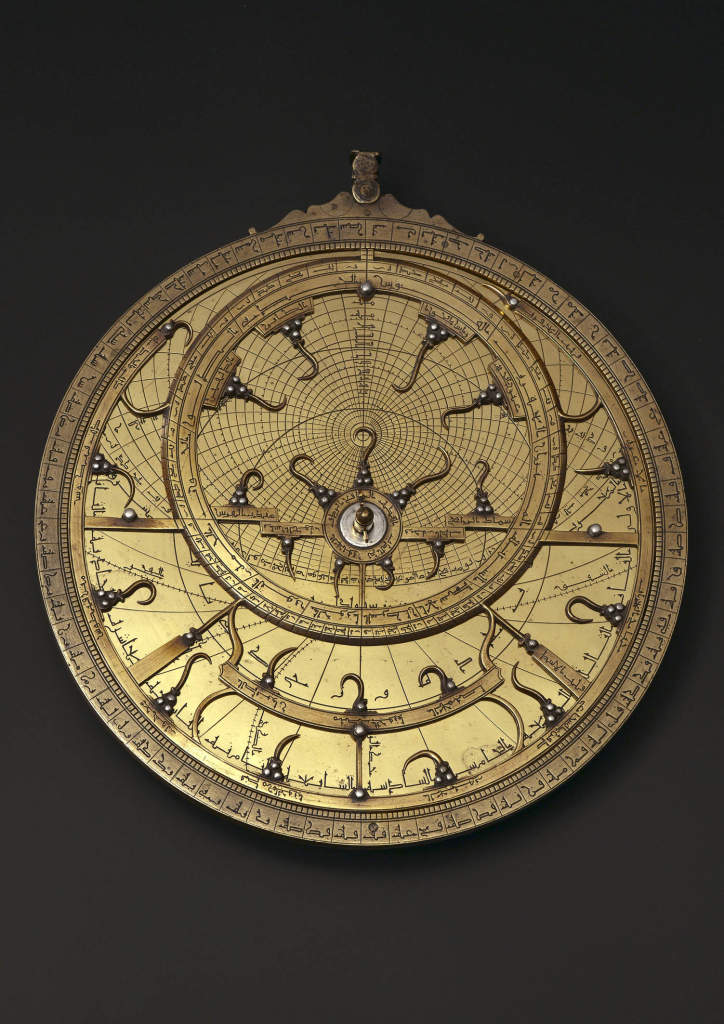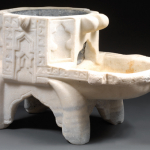Astrolabe made by Muhammad ibn Ahmad al-Battûtî in the Maghrib in 1139 Hijra, that is, 1726/27
Brass, with numerous silver studs.
Height: 24.2 cm. Diameter: 21.9 cm. Diameter plates: 19.6 cm. Thickness: 0.65 cm.
Provenance: Formerly Collection J.R., Algiers, October 1888.
Bibliography :
Laure Soustiel, Astrolabe inédit, par Muhammad ibn Ahmad al-Battûtî, Publication Laure Soustiel et Pierre-Guilhem Métayer, Aix-en-Provence, juin 2009.
Maddison et Brieux (Ed. Bruno Halff), Répertoire des astrolabistes, Editions CNRS, 2009 (en cours de publication)
Planispheric astrolabe including four plates.
The markings serve :
1a – 21°40’ Makka
1b – 25°30’ Madina (“the City of the Prophet, may God bless and save Him”)
2a – 28° Draa (Dar’a)
3a – 30° Cairo, Sijilmasa
3b – 33° Jerusalem, Marrakesh
4a – 34° “Miknasat al-Zaytûn”, that is, Meknes
4b – 36°37’ Tunis
2b – 41° Istanbul
The rete is in a form typical of Maghribî astrolabes. There are pointers for 7+7+6+7 named stars within the four quadrants starting counter-clockwise from the vernal equinox on the left, that is, the standard Maghribî selection of 27 stars. At the base of these pointers there are silver studs, often three on a single pointer. Also there are silver knobs on the horizontal axis and at the top of the ecliptic ring to facilitate rotating the rete.
The mater is devoid of markings. The throne (kursi) is low and in a very distinctively Maghribi style. The scale around the limb of the mater is divided into 5° intervals from 5° to 360°, subdivided for each 1°.
The maker is named in an inscription on the back: “The maker [of this astrolabe] is Muhammad ibn Ahmad ibn al-Hasan al-Battûtî – may God grant him success, Amen – [in] the year 1139 (Hijra).” The date is written in the Maghribî forms of the “Hindu-Arabic” numerals, and the form for “1” is the Roman form “I.
A later Arabic inscription has been added in the formerly empty space around the lower perimeter of the back. The engraving is not expert and parts of the text are difficult to read. We read:
“[This astrolabe] was donated as a religious endowment by al-Mu’azzam Muhammad, head of the cavalry, to the Grand Mosque of Algiers, (city) protected by God. Let nobody take it out of the said mosque [although it is in order that] the muwaqqits [that is, the astronomers of the mosque responsible for timekeeping and the regulation of the times of prayer] should examine it [and use it]. [The endowment was established] at the end of Rajab, 1158 (Hijra)/A.D. 1745.”
The inscription informs us that the astrolabe was related to the Grand Mosque (al-jâmi’ al-a’zam) in Algiers, protected (by God) (al-jazâ’ir al-mahmiyya). At the end of the inscription the professional mosque timekeepers (al-muwaqqitîn), responsible for the regulation of the times of prayer, are mentioned, as well as the end of the month of Rajab, 1158 Hijra, that is, August 20, 1648. It is not unreasonable to suppose that this astrolabe was used by the muwaqqits of the Grand Mosque to which it belonged in order to help regulate the times of the five daily prayers. They also had access to various sorts of astronomical tables for this purpose, of which some computed specifically for the latitude of Algiers have survived. The astronomers could have used the plate for Tunis, since medieval astronomers used the same latitude for Tunis and Algiers.
There is the alidade with two sighting vanes, a pin and a little horse.
This astrolabe offers several interests: Not only it is signed and dated (A.H. 1139/ A.D. 1726-27), but it has an historical inscription dated A.H. 1158/A.D. 1745 that relates it to the Grand Mosque of Algiers. Moreover, it is a large instrument, in very good condition, it includes four plates and the rete still has silver studs.





